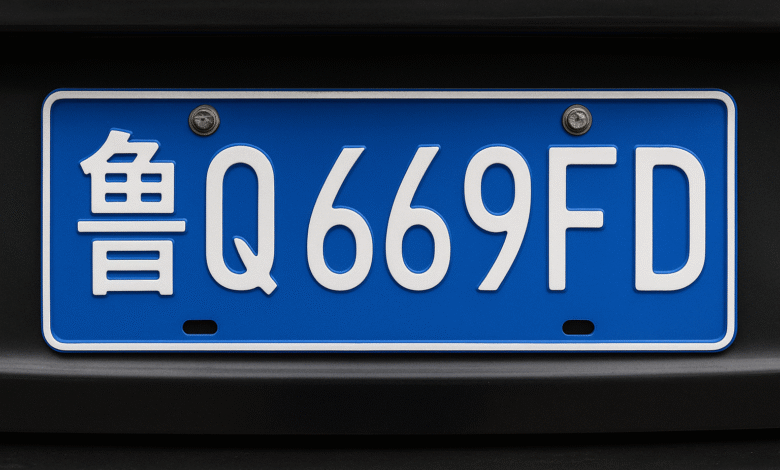Understanding 鲁Q 669FD: A Detailed Look into Chinese Vehicle License Plates

In China, vehicle license plates are more than just random combinations of letters and numbers. They carry information about the location, the category of the vehicle, and sometimes even cultural or social meaning. One example that has sparked curiosity is 鲁Q 669FD. This particular combination might look like a string of random symbols to someone unfamiliar with the Chinese vehicle registration system, but to those who understand the structure, it provides a wealth of information.
This article explores what 鲁Q 669FD represents, how Chinese license plates are structured, why these plates matter in everyday life, and the cultural significance behind them. By examining this specific plate, we can better understand the logic and system behind vehicle registration in China.
Breaking Down 鲁Q 669FD
The license plate 鲁Q 669FD can be broken into two major components: the regional prefix and the alphanumeric identifier.
The Regional Prefix – 鲁Q
The first character, 鲁 (Lǔ), is the abbreviation for Shandong Province in eastern China. Every province in China has its own one-character abbreviation derived from historical or geographical references. “鲁” comes from the ancient State of Lu, a historical kingdom that was located in present-day Shandong.
Following the character 鲁 is the letter Q. In China’s license plate system, the letter following the provincial abbreviation indicates the city or prefecture-level area where the vehicle is registered. In this case, 鲁Q refers specifically to Linyi City in Shandong Province.
The Unique Identifier – 669FD
The second part of the plate, 669FD, is the unique vehicle code. This combination of numbers and letters differentiates one vehicle from another within the same region. While the provincial character and city code may be shared by thousands of vehicles, the alphanumeric string ensures that no two license plates in that jurisdiction are identical.
The Structure of Chinese License Plates
China’s vehicle registration plates follow a fairly standardized structure:
-
Province Code – A single Chinese character representing the province or municipality.
-
City Code – A Latin letter representing the city or region within the province.
-
Unique Vehicle Code – Five characters, which can be a mix of numbers and letters.
For example:
-
京A 12345 – Beijing (京) with city code A.
-
粤B 678CD – Guangdong (粤) with city code B.
-
鲁Q 669FD – Shandong (鲁) with city code Q, meaning Linyi.
This system makes it easy for authorities to quickly identify where a vehicle is from, and it also helps citizens recognize cars from different regions while traveling.
Why 鲁Q 669FD Matters
While at first glance 鲁Q 669FD may seem like any other plate, it represents a slice of China’s well-organized vehicle registration system. There are several reasons why such plates hold significance:
Efficient Vehicle Management
With over 400 million registered vehicles in China, managing and tracking them is a massive task. The license plate structure helps law enforcement, toll systems, and parking facilities manage vehicles efficiently. 鲁Q 669FD fits into this larger framework, making it easy for authorities to instantly know the province and city where the car is registered.
Law Enforcement and Safety
Plates like 鲁Q 669FD are crucial for traffic monitoring, detecting violations, and tracking stolen vehicles. With the help of Automatic Number Plate Recognition (ANPR) systems, police can scan plates instantly to check whether a car is stolen, whether its registration has expired, or whether it is connected to any criminal activity.
Regional Identity and Pride
For many drivers, the plate’s prefix is a matter of local pride. Someone from Linyi might feel a sense of identity when they see another 鲁Q plate while traveling far from home. It can create a small moment of connection between strangers on the road.
Technology Behind the Plates
In the modern era, license plates like 鲁Q 669FD are not just static identifiers. They are deeply integrated with technology.
Smart City Integration
Many cities in China have smart traffic systems that automatically read plates at toll booths, parking lots, and restricted zones. This allows for:
-
Automated toll collection – Cars pass through toll gates without stopping.
-
Parking management – Drivers enter and exit parking lots without needing paper tickets.
-
Traffic flow monitoring – Authorities can study traffic patterns to improve road planning.
Electronic Tags and Future Trends
China has also been experimenting with electronic license plates, which embed chips for more secure and efficient identification. While 鲁Q 669FD is a standard metal plate, future versions might include encrypted data storage for even faster recognition.
Cultural and Social Aspects
Interestingly, some license plates in China become minor celebrities in their own right. Unique number sequences, symmetrical patterns, or culturally significant numbers can make certain plates highly desirable. For example, the number “8” is considered lucky because it sounds like the word for wealth in Chinese, while “4” is often avoided because it sounds like the word for death.
While 鲁Q 669FD does not appear to have such cultural numerology, it still represents the potential for a plate to become a talking point—especially when spotted online or linked to notable events.
Special License Plates in China
Beyond standard plates like 鲁Q 669FD, China issues a range of special plates:
-
Green plates – For electric and hybrid vehicles.
-
Black plates – For vehicles owned by foreign companies or individuals.
-
Yellow plates – For large vehicles such as trucks and buses.
-
Military plates – Used by the armed forces, with unique formats.
This variety allows authorities to instantly categorize vehicles based on purpose and ownership type.
Legal Regulations and Enforcement
Owning a plate like 鲁Q 669FD comes with legal responsibilities. Chinese traffic laws require drivers to display their plates clearly at all times, and tampering with or obscuring a plate is a serious offense. Penalties can include fines, points deducted from the driver’s license, and even vehicle impoundment.
In recent years, Chinese authorities have increased their efforts to detect fake plates or altered numbers. With the integration of high-resolution cameras and AI systems, it has become much harder to get away with such activities.
The Global Perspective
The concept of regional license plate prefixes is not unique to China. Countries like Germany, Japan, and the United States also have systems that indicate a vehicle’s place of registration. However, China’s use of a single Chinese character followed by a Latin letter is distinctive and instantly recognizable.
For international travelers in China, spotting a plate like 鲁Q 669FD can spark curiosity about its meaning. Understanding the structure can make road trips more interesting, as each plate tells a small story about where a vehicle comes from.
Read also: Everything You Need to Know About 192.168.28.57:5421
Conclusion
鲁Q 669FD is more than just a random arrangement of letters and numbers—it is a compact piece of information about a car’s origin, part of an efficient national registration system, and a reflection of how modern technology integrates with everyday life.
From identifying a vehicle’s home city to enabling advanced traffic management systems, plates like 鲁Q 669FD are a vital part of China’s transportation infrastructure. They represent not just a legal requirement but also a cultural marker that connects people to their region.
In the years ahead, as license plates evolve with technology, identifiers like 鲁Q 669FD may carry even more digital features, but their core purpose—clear, structured vehicle identification—will remain the same.



